November 17, 2017
Air Date: November 17, 2017
FULL SHOW
SEGMENTS

'America’s Pledge' to Paris
View the page for this story
With President Trump walking back U.S. climate change mitigation efforts, including the Paris Climate agreement, a coalition of U.S. cities, states, and businesses representing more than half of the U.S. economy promises to continue reducing emissions. Host Steve Curwood describes the launch of America’s Pledge at the UN climate talks in Bonn, Germany, as we hear from key leaders in this commitment, including former New York City Mayor Michael Bloomberg and California Governor Jerry Brown. (03:12)
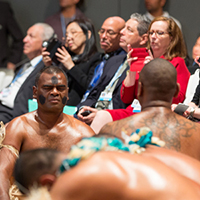
Moving Forward at COP23 Climate Summit
View the page for this story
As delegates thrashed out details on how to count emissions cuts accurately, and map the next steps forward, America’s Pledge made a big splash in Bonn at the 23rd Climate Conference of the Parties, COP 23. Host Steve Curwood catches up with Alden Meyer of the Union of Concerned Scientists, who says that financing continues to cause friction between donor countries and developing nations. (10:50)

Trump Pumps Alaskan Gas Deal
View the page for this story
In a move promoted by President Donald Trump and Chinese President Xi Jinping, Alaska has signed an agreement with China to build an 800-mile natural gas pipeline, but economic hurdles cloud its construction. Alaska Dispatch Reporter Alex Demarban tells Host Steve Curwood what the $43 billion project could mean for Alaska. (05:10)
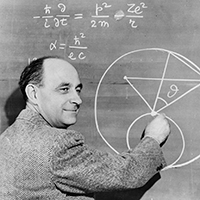
Beyond The Headlines
/ Peter DykstraView the page for this story
Peter Dykstra returns to discuss with host Steve Curwood news of the severe air pollution that blankets India’s capital Delhi, and the exit of a major coal mining company from the coal business. In this week’s edition of Beyond the Headlines, they also turn the pages of the history calendar back 75 years to find Enrico Fermi working beneath an old football grandstand to produce the first self-sustained atomic chain reaction. (03:14)
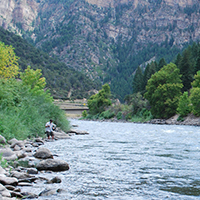
The Rights of Nature: A Legal Revolution That Could Save the World
View the page for this story
Environmental lawyers are claiming in court that land, rivers, and other natural features should own themselves rather than being considered property, much like the law already treats corporations as ‘persons.’ The case for treating elements of nature as legal ‘persons’ is outlined in the book, Rights of Nature: A Legal Revolution That Could Change the World by environmental lawyer David Boyd. In a conversation with Living on Earth Host Steve Curwood he explained how this approach can go a long way to protecting critical ecosystems from human exploitation and destruction. (21:03)
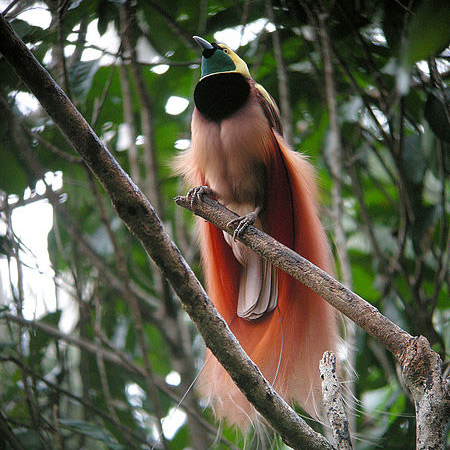
BirdNote: Birds of Paradise
/ Mary McCannView the page for this story
Some birds are downright gorgeous, and as BirdNote’s Mary McCann explains, few are quite as beautiful and exotic as New Guinea’s Birds of Paradise. (02:10)
Show Credits and Funders
Show Transcript
HOST: Steve Curwood
GUESTS: Alden Meyer, Alex Demarban, David Boyd
REPORTERS: Peter Dykstra, Mary McCann
[THEME]
CURWOOD: From Public Radio International, this is Living on Earth.
[THEME]
CURWOOD: I'm Steve Curwood. As the US heads for the door of the Paris Climate Agreement, hundreds of American business folk, mayors and senators at the UN Bonn summit say “We’re still in”.
MARKEY: We are here in Bonn to say that we are not saying "Bonn-voyage" to our commitment to climate action on our planet. That is why we are here!
CURWOOD: Also, arguing that Nature should have fundamental rights….
BOYD: Corporations have all kinds of rights, for better or for worse, under Canadian and American law. And when you put it to people that why should corporations have rights and not rivers -- That idea that rights can extend beyond humans to other entities, I find people tend to take a step back and go, “Oh, let me think about that.”
CURWOOD: That and more, this week on Living on Earth. Stick around.
[NEWSBREAK MUSIC: Boards Of Canada “Zoetrope” from “In A Beautiful Place Out In The Country”, Warp Records 2000]
[THEME]
'America’s Pledge' to Paris

Audience members cheer and hold up signs at the America’s Pledge unveiling on Saturday, November 11th 2017 in Bonn, Germany at the 23rd Conference of the Parties (COP23). (Photo: UNclimatechange, Flickr CC BY-NC-SA 2.0)
CURWOOD: From PRI, and the Jennifer and Ted Stanley Studios at the University of Massachusetts Boston, this is Living on Earth. I’m Steve Curwood.
[PROTESTORS: What do we want? Climate justice! When do we want it? Now!]
CURWOOD: The US delegation invited the public in for its only official climate presentation at COP23, this year’s UN Conference of Parties in Bonn, Germany. The Trump team came to push coal and nuclear power, and the room was packed, but mostly with protestors.
[AUDIENCE: SINGING TO THE TUNE OF “PROUD TO BE AN AMERICAN”,
“SO YOU CLAIM TO BE AN AMERICAN, THOUGH WE SEE RIGHT THROUGH YOUR GREED.
IT’S KILLING ALL ACROSS THE WORLD FOR THAT COAL MONEY.
AND WE PROUDLY STAND UP UNTIL YOU KEEP IT IN THE GROUND…”]
CURWOOD: Even as President Trump says he will pull America out of the Paris Climate Agreement unless he gets a “better deal,” the rest of the world is moving ahead to fulfill the landmark accord. And if the Administration won’t do it, a group of American governors, mayors and business leaders who came to Bonn midway through COP23 say they surely will. They call their bold claim to keep the U.S. committed to its Paris Agreement goals “America’s Pledge”. COP23 President and Fijian Prime Minister Frank Bainimarama kicked off the event.
[APPLAUSE]
BAINIMARAMA: They may be called non-state actors in this process, but make no mistake. They are leading actors in driving more ambitious climate action in their states and cities in this critical pre-2020 period. And we can’t do it without them.

Cost comparisons for new-build levelized costs of electricity (renewables vs. fossil fuels, on left) and new renewables vs. marginal cost of existing fossil fuel plants (right) help build the case for increased deployment of renewable energy in the America’s Pledge Phase 1 Report. (Photo: America’s Pledge Phase 1 Report)
CURWOOD: New York City mayor and philanthropist Michael Bloomberg says that America’s Pledge can keep the U.S. on track with its Paris commitments.
BLOOMBERG: We hope our pledge will be accepted alongside the nationally determined contributions that every other party makes. Through America’s Pledge, we will continue measuring and reporting our progress on reducing emissions, just as every other nation has committed to do, so that the world can hold the United States accountable for reaching our commitment.
CURWOOD: The cities, states, and businesses that have voluntarily decided to be held accountable can make a big dent in global emissions, Mayor Bloomberg told the crowd.
BLOOMBERG: And together this coalition represents more than half of the entire U.S. economy. If this group were a country, we would have the world’s third largest economy.
CURWOOD: Pittsburgh has joined America’s pledge, and its mayor Bill Peduto spoke for cities in America like his, which built their old economies with fossil fuels.
PEDUTO: And in the heart of coal country, in the heart of natural gas, in the heart of the oil country, there was a different idea that within that city could blossom a new economy. And today we see it, where there are more people employed in green energy than oil, coal, and gas combined, and Pittsburgh’s economy has come back.
CURWOOD: All it takes, says Mayor Peduto is planning and dedication:
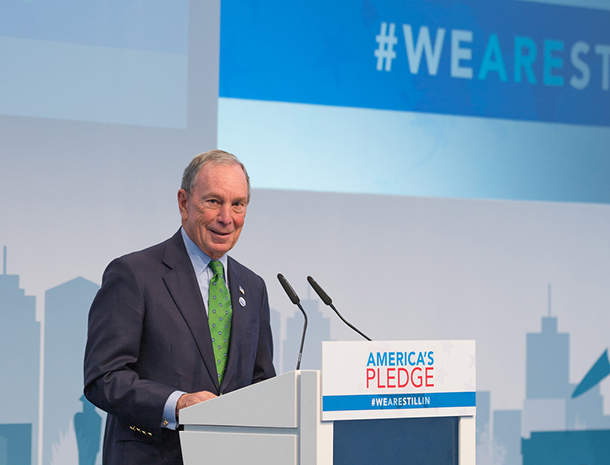
Former New York City Mayor Michael Bloomberg at the podium during the America’s Pledge session at COP23. (Photo: UNclimatechange, Flickr CC BY-NC-SA 2.0)
PERDUTO: We have to create a Marshall Plan within the United States, that concentrates on the areas that have been left behind, and the people that feel this is not a part of their future, or their children’s future, and let’s start building those wind turbines in West Virginia, let’s start building those solar panels in Eastern Ohio, and let’s start giving them an opportunity to join with us and change this country’s track.
[APPLAUSE, CHEERING]
CURWOOD: California already has a cap and trade program for global warming gas emissions, which includes Canada. And Governor Jerry Brown came to Bonn to offer his roadmap for protecting the climate:
BROWN: So, California is the most aggressive, the most far-reaching climate action state in the country, in the Western Hemisphere.
[APPLAUSE, CHEERING]
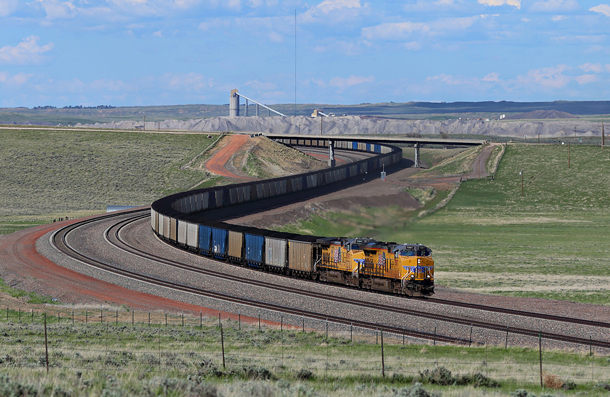
At this year’s UN Conference of the Parties, the annual global climate change talks, the U.S. delegation appeared publicly only once, in an event to promote the role of “clean coal” and nuclear energy in climate mitigation. (Photo: Jerry Huddleston, Flickr CC BY 2.0)
By the way, is it enough? No. Do we have a lot of pollutants? Yes. Do we have 32 million cars driving 335 billion miles every year? Yes. Are we going to stop them today? No. Are we going to stop them in time? Yes, if the America’s Pledge is picked up by the rest of the country and the rest of the world, which it will. And that’s why we’re here.
CURWOOD: Walmart’s Senior Vice President of Sustainability, Laura Philipps, spoke for America’s businesses as she outlined Wal-Mart’s commitment to a greener supply chain.
PHILIPPS: We have a responsibility to actually look out into how our products are being manufactured and used and think about the emissions of our products, not just in our own operations. And for Wal-Mart we’ve really learned that our work in climate, number one, it’s been really good for our business. So we’ve seen that our investments in energy efficiency, our investments in renewable, have saved us a lot of money.
CURWOOD: Even though the US executive branch of government is rolling back climate action, legislators including Democratic Senator Ed Markey of Massachusetts joined the “America’s Pledge” event.
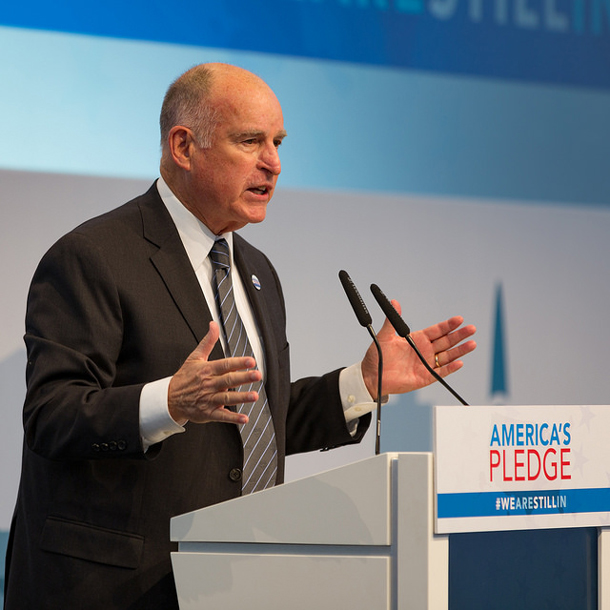
California Governor Jerry Brown speaking at the America’s Pledge event on November 11th, 2017. (Photo: UNclimatechange, Flickr CC BY-NC-SA 2.0)
MARKEY: We are here in Bonn to say that we are not saying “Bonn-Voyage” to our commitment to climate action on our planet.
[LAUGHTER]
That is why we are here!
[APPLAUSE]
CURWOOD: And the climate-denying policies of President Trump are on thin ice, Senator Markey declared.
MARKEY: President Trump might want to “cop out” on climate action, but we know that C-O-P really stands for “Can’t Obstruct Progress;"
[APPLAUSE AND CHEERS]
That “Climate outlasts presidents."
CURWOOD: Massachusetts Democrat, Senator Ed Markey.
Related links:
- The America’s Pledge Phase 1 Report
- PRI’s The World: “There’s a deep divide over Trump climate policy on display at UN talks”
- The Guardian: “Pittsburgh fires back at Trump: we stand with Paris, not you”
- Our Living on Earth story about the “We Are Still In” declaration
Moving Forward at COP23 Climate Summit
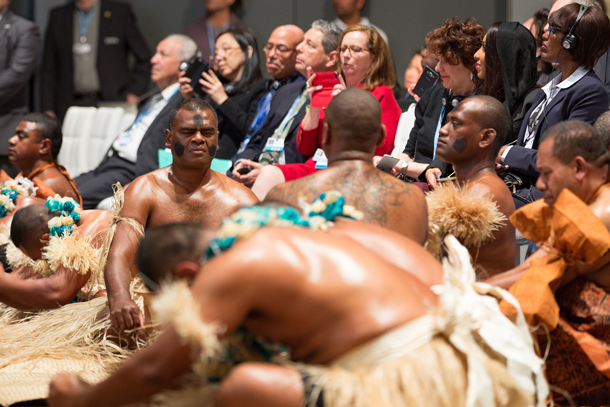
A Fijian traditional welcome ceremony kicked off COP23, which is being presided over by the Government of Fiji. (Photo: UNclimatechange, Flickr CC BY-NC-SA 2.0)
CURWOOD: Even though the US is largely standing aside from the Paris Climate Agreement for now, the rest of world made implementing Paris the primary work of COP23 in Bonn. And with us now to help navigate what’s been done and what lies ahead is Alden Meyer of the Union of Concerned Scientists.
Hi, Alden. Welcome back to Living on Earth.
MEYER: Thanks, Steve, good to be with you again.
CURWOOD: Hey, Alden. Great to have you here. I understand that there was A US Climate Action Center that attracted a lot of attention.
MEYER: Yeah, it did. This was put together by the "We Are Still In" coalition of mayors and governors and business leaders, university presidents and others that wanted to demonstrate to the world that, despite the actions of President Trump announcing he's going to withdraw the US from the Paris Agreement, that major elements of US society remain committed to achieving our goals under Paris. They're taking action to drive the clean energy revolution forward, to de-carbonize their business sectors, to make sure that we have a shot at meeting the commitments that President Obama made under Paris. And they really made quite a splash here, and I think they really got the word out that Donald Trump does not speak for the real United States.
CURWOOD: So, Alden, what were the big takeaways from this year's UN climate Conference of the Parties, COP23?

Negotiators from all around the world spent two weeks ironing out details in the implementation of the Paris Agreement at the 23rd Conference of the Parties (COP23) in Bonn, Germany in November 2017. (Photo: UNclimatechange, Flickr CC BY-NC-SA 2.0)
MEYER: Well, this was kind of an in-between COP, in-between Paris, and the meeting in Poland next year. They had to lay the groundwork for a discussion of collective adequacy of ambition against the Paris temperature targets. We already know that countries aren't doing enough collectively to come anywhere close to meeting the temperature limitation goals in Paris. United Nations Environment Program put out a report on that the week before the COP, showing that, if we stay on the current commitments, we would only get one-third of the way to where we need to be by 2030 to have a fighting chance to stay well below two degrees Celsius temperature increase. So, that's job one, is to lay the groundwork for this discussion next year in Poland about how we will raise our game, try to close that gap.
Another thing, of course, they focused on here is the implementation rules for Paris itself, things like accounting for land use emissions, market mechanisms, emissions trading, transparency in reporting of national efforts to constrain their emissions, which of course has been a primary goal for the United States under both Republican and Democratic administrations for the last decade or so. And then of course the perennial issue of finance, which is actually what's the only remaining issue as we speak pending right now. There's a big fight going on about how developed countries will be more transparent about how they intend to meet the hundred billion dollar by 2020 per year commitment they made in Copenhagen to help developing countries de-carbonize their development paths and also cope with the mounting impacts of climate change.
CURWOOD: Alden, there's been a lot of concern about loss and damage and here's a year we saw tremendous flooding in the developing part of the world. How are these negotiations addressing concerns by developing countries about how to handle loss and damage?
MEYER: Well, it's been very frustrating for the vulnerable countries here because there is a program that was launched in Warsaw in 2013, the so-called Warsaw International Mechanism for Loss and Damage, which has been looking at this issue. How do you use insurance? How to use government funding to try to help countries that are facing these, these sudden impacts? And they continue to do the technical work, but the developed countries including the United States have been blocking any political space where they can start to discuss how they start to ramp up substantial amounts of funding.
???? Activists at the U.N. climate talks have unfurled a banner—"Keep it in the ground"—ahead of German Chancellor Angela Merkel's address to #COP23, urging her to phase out coal immediately pic.twitter.com/sXiohm3upi
— Democracy Now! (@democracynow) November 15, 2017
CURWOOD: In other words it's like the Cuba Gooding character in Jerry Maguire. “Show me the money?”
MEYER: Show me the money. Show me how you're going to help me deal with resettlement of refugees from islands, how you're going to deal with economies like Fiji, which is the presidency of this COP. They suffered tremendous damage a few years ago from Typhoon Winston, wiped out about one-third of their economy. They’re just recovering from that, and, of course, just recently we saw devastating hurricanes for Barbuda, Puerto Rico, other islands in the Caribbean. So, this is a growing issue. It's an issue of urgency for these countries. But so far the US, Europe, Japan, other developed countries haven't been willing to open up a conversation about how you meet those needs long term.
CURWOOD: And at this meeting, I think there's a bit of bad news, isn't it? That global greenhouse gas emissions are on the rise after being relatively flat over the past two or three years?
MEYER: Yeah, that that information just came out during, during the Conference of the Parties here. We have been relatively flat the last two or three years. It looks like preliminary figures for 2017…So, there could be as much as a two, or two-and-a half percent increase and in carbon emissions driven largely by China with some other countries coming in. So, of course, if that was the beginning of a trend that would be quite worrisome, but it just shows, I think, that despite the celebration over Paris, this is by no means in the bank. There's hard work that needs to be done in all countries, and the fact that coal plants continue to get financed in Vietnam and Indonesia and India and other places just shows that we haven't turned the corner yet.
CURWOOD: Explain for people who may not know the UN climate negotiation process intimately, as you do, how non-state actors get involved in this?
MEYER: Well, non-state actors include businesses, non-governmental organizations like UCS [Union of Concerned Scientists], indigenous groups, labor union, youth groups, research institutions. There's a whole infrastructure of different constituencies in this UN process, and they play a vital role both trying to influence the negotiations and the positions that countries take, talking to the media and to the public about what's going on here, but also in the wake of Paris playing a critical role in implementation of the agreements because if you think about it, the states, the cities, the business community, the research institutions, the development group, they really are where the rubber meets the road and in terms of implementation and reducing emissions. In this dialogue, that's going to be held in Poland next year, the presidency, the Fiji presidency has made a lot of space for engagement of these non-state actors in the process, realizing that we have a lot to bring to the table and that we're essential to implementation of any commitments that countries make.
CURWOOD: Massachusetts Democratic Senator Ed Markey at the Americas Pledge session kind of cracked a joke saying that COP stands for Climate Outlasts Presidents. To what extent are folks there feeling that Mr. Trump's approach is but a blip in the US approach to this?
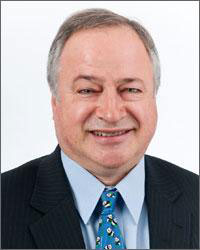
Alden Meyer is director of strategy and policy for the Union of Concerned Scientists and the director of its Washington, D.C. office. (Photo: Union of Concerned Scientists)
MEYER: Well, I think people were given a lot of comfort by the highly visible presence here of senators and governors, mayors, business leaders from the US. You're seeing a joint effort by China, the European Union and Canada through this process they launched in September called the Ministerial on Climate Action or MOCA. It kind of replaces the major economies forum that the Obama administration was spearheading over the last eight years. This is a space where ministers come together periodically to assess progress, to talk about how they can do more. There's going to be the next meeting of this group in the spring in Europe, and then China will host a meeting in the fall next year. That's one place where leadership will be coming from.
People aren't waiting for the Trump administration. They, they plan to take action on their own. They're talking about work on electric vehicles, on renewable energy. Just today you had 21 countries and states announce that they were committed to phasing out use of coal in the relatively near future. I think they hope by Poland next year to build that up to 50. So, there's all kinds of initiatives going on without the United States in the picture.
The real test I think will come over these next three years out to 2020 when countries have to make decisions about whether they're going to strengthen their commitments and if so by how much. That's when we'll see the acid test of whether the US pulling back has, has really made an impact on the willingness of other countries to move forward.
CURWOOD: Alden Meyer is, the Director of Strategy and Policy for the Union of Concerned Scientists. Alden, thanks so much for taking the time with us today.
MEYER: It was great to be with you, Steve.
Related links:
- UN Climate Change Conference in Bonn, November 2017
- The Guardian: “Indigenous groups win greater climate recognition at Bonn summit”
- NYTimes: “Protestors Jeer as Trump Team Promotes Coal at U.N. Climate Talks”
- About Alden Meyer
CURWOOD: Your comments on our program are always welcome. Call our listener line anytime at 800-218-9988. Our e-mail address is comments at LOE.org. That's comments at LOE.org. And visit our web page at LOE.org. That's LOE.org. Coming up...President Trump strikes a natural gas deal with China. That’s just ahead on Living on Earth.
[MUSIC: Pau (Pablo) Casals, “Cello Suite No.1 in G, BWV 1007, Prelude” on Bach: Suites for Cello, 1, 2 & 3 composed by J.S. Bach, EMI]
ANNOUNCER: Support for Living on Earth comes from the Gordon and Betty Moore Foundation, and from a friend of Sailors for the Sea, working with boaters to restore ocean health.
[MUSIC: Pau (Pablo) Casals, “Cello Suite No.1 in G, BWV 1007, Prelude” on Bach: Suites for Cello, 1, 2 & 3 composed by J.S. Bach, EMI]
Trump Pumps Alaskan Gas Deal
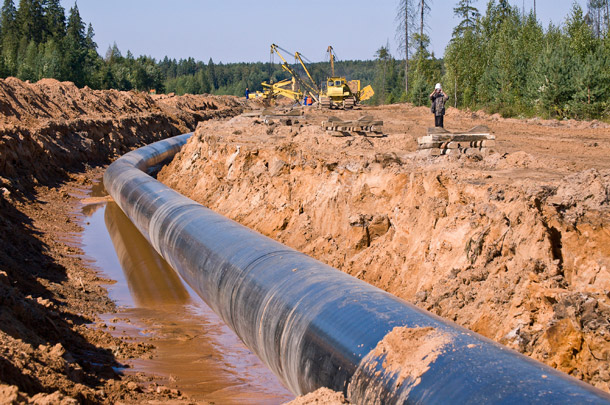
The proposed pipeline would primarily run from Prudhoe Bay to the town of Nikiski, Alaska, much of it underground, in contrast to the existing oil pipeline. (Photo: NPCA Online, Flickr CC BY 2.0)
CURWOOD: It’s Living on Earth, and I’m Steve Curwood.
Alaska has the largest oil field in North America, with an 800-mile long pipeline to bring all that crude from the far North Slope to Valdez where tankers load up. And ever since the Trans Alaska Pipeline went into service in 1977, industry has talked about constructing a parallel one to tap the region’s vast reserves of natural gas. Well, President Trump has now added to that talk by promoting a preliminary deal with China during his recent visit with President Xi. Alaska and China would split the $43 billion tab to finance and build the pipeline and terminals, and China would guarantee the purchase of the gas.
Alex Demarban, is an oil and gas reporter for Alaska Dispatch News and joins us now. Welcome to Living on Earth, Alex.
DEMARBAN: Thank you very much, glad to be here.
CURWOOD: So, why is getting liquefied natural gas to Asian market such an attractive option for Alaska?
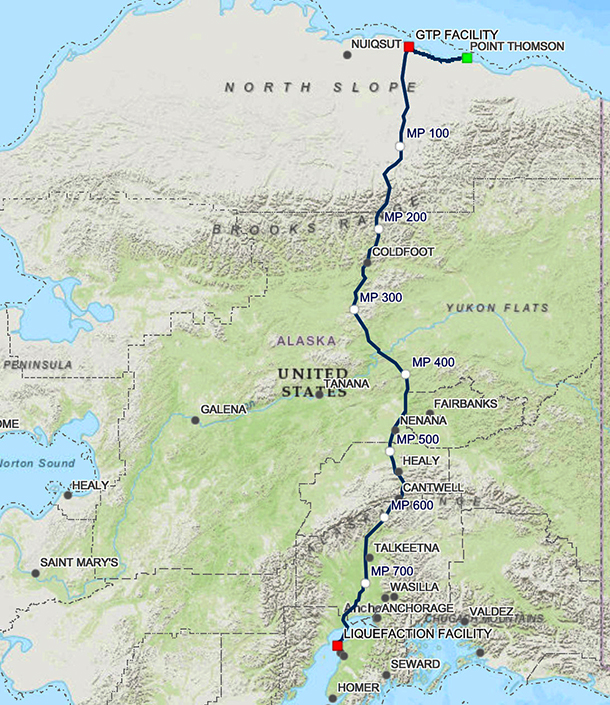
The proposed natural gas pipeline in Alaska would parallel the existing oil pipeline most of the way south, branching to reach a liquefaction facility south of Anchorage. (Photo: Alaska LNG via Alaska Department of Natural Resources map)
DEMARBAN: Well, one of our projects, a gas line in the past that looked at moving gas to the lower 48 [states]...It would just be gas gas, it would not be liquid gas. That changed once we had the shale revolution in the lower 48. There's plenty of gas there now, so then it became a matter of looking at what other markets are out there. So, about six years ago the state began looking at moving gas efficiently to Asia.
CURWOOD: Tell folks where this pipeline would actually be built.
DEMARBAN: So, the pipeline would go from the Prudhoe Bay oil fields where the gas is now, and it would follow the Trans Alaska pipeline for much of its route and connect essentially the Arctic Ocean to our Cook Inlet in southern Alaska. So, it would move the gas 800 miles from northern Alaska to southern Alaska, and there in a little town known as Nikiski, the gas would be turned into a liquid in another costly construction project there and then put onto tankers so it could be shipped overseas.
CURWOOD: So, there's natural gas up on the North Slope there on Prudhoe Bay. What happens to it now?

The Chinese Petrochemical company Sinopec Group and Bank of China signed the natural gas development agreement with Alaska Gasline Development. (Photo: Chris HE, Flickr CC BY-NC-ND 2.0)
DEMARBAN: The natural gas is being re-injected back into the ground to keep the pressure up in the underground reservoirs, so it's had a very vital existence because it's essentially allowed for much more production of oil on the North Slope. So, the production of oil up there has been far greater than anticipated, and gas is playing a huge role in that.
CURWOOD: What's the state of Alaska's economy like right now, and how could this deal to put in a natural gas pipeline from the North Slope affect the overall economic situation there?
DEMARBAN: Well, we're in a recession. We have the nation's highest unemployment. We've lost a lot of jobs, particularly high paying jobs in the oil fields. So, we are desperate for a project. There's uncertainty about how much this would financially benefit us, but certainly in the hundreds of millions right away if it pans out, as the state says it would, and billions as the debt is paid off 20 years after it begins production. So, we could easily shrink our deficit.
CURWOOD: So, I gather the deal would involve having the state help finance this thing. What are the barriers there?
DEMARBAN: Well, the barriers to the state helping finance this thing is that we don't have a lot of money. We have a very guarded protectionist view of our Alaska Permanent Fund which has about $63 billion dollars and largely seeded with oil revenues that have grown over time. So, a lot of Alaskans would be politically opposed to that being used for this project. So, where does Alaska get the money? We're not quite sure. That's why we need big partners for this project.
CURWOOD: So, I gather that a firm commitment isn't expected from either the state or the Chinese until sometime late next year. What's your opinion about how likely this deal is to actually go through?
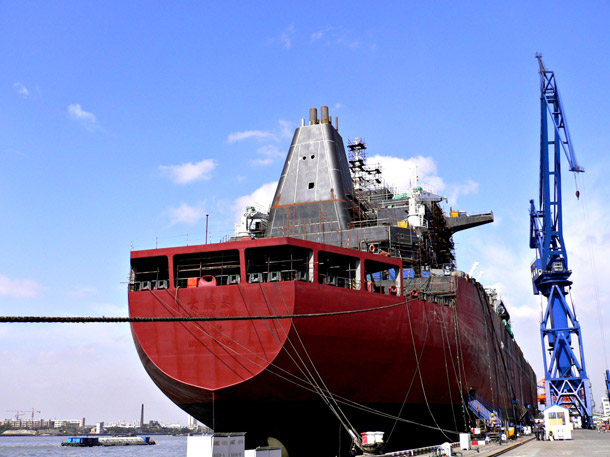
A liquefied natural gas carrier vessel. (Photo: Henry Lawford, Flickr CC BY 2.0)
DEMARBAN: I would give it less than 50 percent. Plus on the one hand you have a lot of LNG competitors around the world, lots of energy projects for China to choose from, and significantly we have here in Alaska, at this point, a high cost project with an uncertainty about the price of gas once the project starts moving gas. On the plus side, we are close to China relative to other LNG projects and can really reduce shipping costs. We've got a huge amount of gas that, once someone swallows that pill up front and agrees to invest, this can move gas for decades. But still I would think less than 50 percent, and hopefully I'll be surprised as an Alaskan with family and you know mortgage and all that stuff.
CURWOOD: It seems to me that this was the biggest deal that Trump brought back from his trip to Asia. How much of this was for show, and how much of this is, well, going to go?
DEMARBAN: Certainly there's an incentive for show here with Trump blasting China over the trade deficit and wanting to show that it's being lowered. That was there for a show. Now it's up to the state and China to get past those political considerations and make something go.
CURWOOD: Alex Demarban is a reporter for Alaska Dispatch News. Thanks so much for taking the time with us today.
DEMARBAN: Yeah, thanks.
Related links:
- Alaska Dispatch News: “Here are 5 big questions about Alaska’s gas line deal with China”
- About the proposed natural gas pipeline project
- Alex Demarban Profile
[MUSIC: The Bad Plus and Joshua Redman, “Silence Is the Question”]
Beyond The Headlines
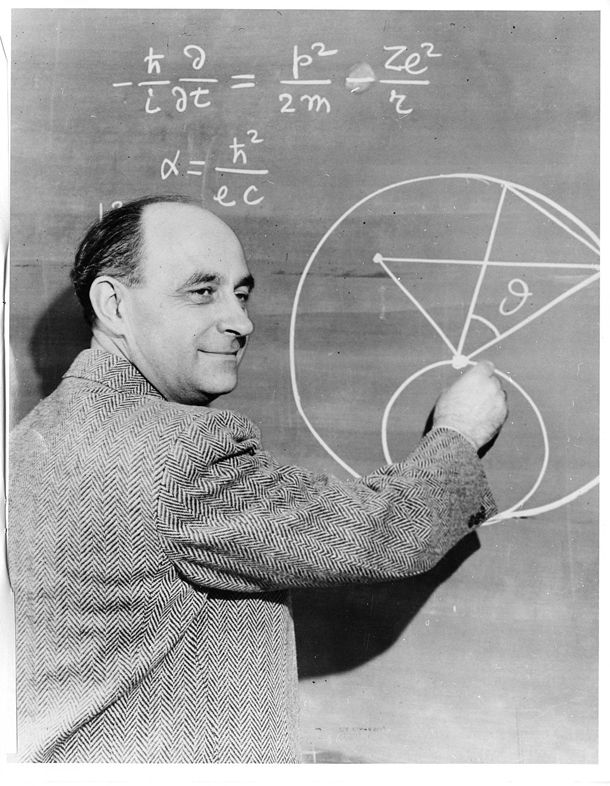
Enrico Fermi, the “architect of the nuclear age,” at the blackboard. This week marks 75 years since the start of the Atomic Age. (Photo: Smithsonian Institution, Wikimedia Commons public domain)
CURWOOD: We’ll check in with Peter Dykstra now, for a visit beyond the headlines. Peter’s with DailyClimate.org and Environmental Health News, that’s EHN.org, and he’s on the line from Atlanta, Georgia. Hey there, Peter, how are you doing?
DYKSTRA: I'm doing OK, Steve, thanks. When it comes to dirty air and out-of-control pollution, China usually gets all of the dubious glory. But y'know what? India is also an air pollution leader. Recent air quality in the city of Delhi was so bad that United Airlines suspended its flights into Delhi last week.
CURWOOD: Whoa, I don't think I recall hearing that happening there before. Some kind of visibility issue for pilots?
DYKSTRA: It’s a safety issue, yeah, but not for taking off and landing, just for breathing. A United spokesperson cited the public health emergency in Delhi as the reason for the suspension. And here's another measurement of Delhi's foul air.
CURWOOD: Go ahead and take my breath away.
DYKSTRA: Yeah, that’s what was happening in Delhi. During the current emergency, the level of fine particle air pollution in the city of 19 million was so high that it's estimated to be equal to smoking 44 cigarettes a day.
CURWOOD: Wow, that’s more than two packs! So why is Delhi’s smog so bad?
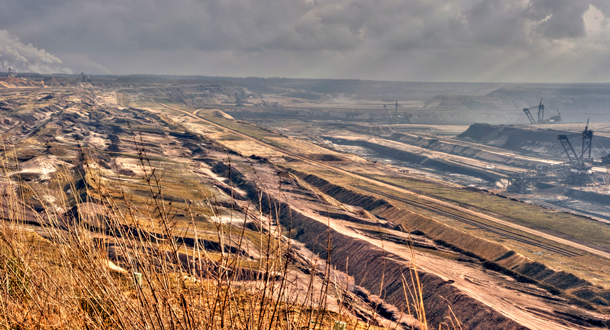
The massive Garzweiler II coal mine in Germany. Climate negotiators say Germany is on a path to stop mining coal by 2030. (Photo: Bert Kaufmann, Flickr CC BY 2.0)
DYKSTRA: There’s several reasons; widespread burning of crop stubble in neighboring states, industrial pollution and rampant construction in the capital on top of chaotic traffic.
CURWOOD: I see, which I guess is obviously more than they can right now in Delhi. Hey, what else do you have?
DYKSTRA: Well I have some mixed news from the coal world. A team of international scientists crunched the numbers for fossil fuel consumption, and they say after three years of virtually no growth in oil, gas, and coal burning, 2017 is poised to show an increase, thanks mostly to more coal use in China.
CURWOOD: Uh, and so let's hear the good side of the mixed news.
DYKSTRA: Well, the good news comes in two parts. First, climate negotiators say Germany is on a path to exit the coal-mining business by 2030.
CURWOOD: And the other?
DYKSTRA: Second is the world's second largest mining company, Rio Tinto. They're completing their exit from the coal mining business and Rio Tinto’s been selling off its coal mines for the past few years. They say they'll be out of the coal sector as soon as they can unload their remaining mines in Australia.
CURWOOD: Seems like coal is more and more out in the cold these days, huh? Hey let's take our regular spin through the history vault. What do you have for us?
DYKSTRA: Well, this past week was the 75th anniversary of what was arguably the start of the Atomic Age. The University of Chicago was a major college football power until abruptly dropping its program in 1939. And what better use for an unused football stadium than to split the atom for the first time? In 1942, Nobel laureate physicist Enrico Fermi built a makeshift lab beneath the football grandstand, and a few weeks later the first self-sustained atomic chain reaction took place.

Thick smog visible from the tarmac at a Delhi airport. (Photo: Veeresh Malik, Flickr CC BY-NC-ND 2.0)
CURWOOD: So one of the defining factors of the 20th century began under a football stadium grandstand, huh?
DYKSTRA: Yup, and here we are, well into the 21st century, the University of Chicago has restored a small-scale football program, and the world has restored its interest, and its anxiety about the bomb.
CURWOOD: Well, let’s just hope they don’t drop one of those. Thanks, Peter.
DYKSTRA: All right, Steve, any time. Talk to you soon.
CURWOOD: That’s Peter Dykstra of DailyClimate.org and Environmental Health News, that’s EHN.org. And there’s more on these stories at our website, LOE.org.
Related links:
- NDTV: “United Airlines Suspends Newark-Delhi Flights Over Severe Air Pollution”
- CNN: “Breathing in Delhi air equivalent to smoking 44 cigarettes a day”
- Climate Home News: “German coal mining could end by 2030s, says Merkel’s coalition negotiator”
- Atomic Heritage Foundation about Enrico Fermi
[MUSIC: Georg Solti/Chicago Symphony Orchestra, “Also Sprach Zarathustra,” on The Solti Collection-Also Sprach Zarathustra composed by Richard Strauss, Decca/Polygram]
The Rights of Nature: A Legal Revolution That Could Save the World

The mighty Colorado River. (Photo: kendiala, Flickr CC BY-NC 2.0)
CURWOOD: Less than 150 years ago in America, black people finally won the right to be full citizens and vote, and voting rights for women followed 50 years later. And less than two decades ago, people in America won the right to marry whomever they choose, regardless of gender. Over time the rights of people to fairness and equality have expanded, and now there is a move to extend intrinsic rights to exist to nature.
Environmental lawyer David Boyd has written a book called "The Rights of Nature: A Legal Revolution That Could Save the World". He says, trees, rivers, and ecosystems have basic rights that we, as a part of nature ourselves, are morally bound to honor. David Boyd teaches law at the University of British Columbia and he joins us now from his home in the San Juan Islands.
Welcome to Living on Earth, David.
BOYD: It's a real pleasure to be with you, Steve.
CURWOOD: So, a legal revolution that could save the world. Explain the concept of personhood rights for nature and why you believe it's not such a wacky idea.
BOYD: OK. Well, you know, people think of a wacky idea as being human rights for nature, and that's not what we're talking about here. We're not talking about chimpanzees or endangered species or ecosystems having human rights, like the right to vote. What we're talking about is legal recognition of the rights of animal species and nature. And in our western legal systems we've recognized the legal rights of non-human persons for many, many years. So, examples include municipalities and corporations that we designate as legal persons, and then through the law we articulate what are the rights of a corporation, for example. So now what's emerging around the world in terms of the rights of nature are, what are the rights of a river? What are the rights of a chimpanzee? What are the rights of an ecosystem? So, we have to be quite clear in distinguishing human rights, which we're not talking about, from the rights of legal persons which we are talking about.
CURWOOD: Now, you live among the San Juan Islands off Vancouver and Seattle, and you write in your book about your relationship with a particular set of sentient creatures, and you suggest that maybe they inspired you to do this work. Talk to me about those creatures and what you've observed and why they inspired you.
BOYD: Uh-huh. Well, Steve what you're referring to there are a population of killer whales that live here. They're called the Southern Resident Killer whales and they are an absolutely extraordinary species that swims past Pender Island routinely during the spring, summer, and fall in pursuit of Chinook salmon which make up 80 percent of their diet. Now, these Southern Resident Killer whales suffered a severe blow in the 1960s and 1970s when over 50 of them were kidnapped and taken for display in aquariums in Canada, the United States, and around the world, and as a result they've been on Canada's endangered species list for decades now. Unfortunately, their population is not recovering, and that's because of declines in Chinook salmon, pollution of the ocean and disturbance from vessel noise. But I have a little writing cabin where we live here on Pender Island, and I can actually hear those whales when they're going past.

An orca pod swims together off of South Pender Island. (Photo: Andrew Reding, Flickr CC BY-NC-ND 2.0)
[SOUTHERN RESIDENT KILLER WHALE SOUNDS]
BOYD: Once, I was on a sailboat and the captain threw a hydrophone overboard when we came across a pod of killer whales, and I can tell you that about 12 of us were on board and all of us were literally in tears listening in on the communication. I would call it a conversation between these killer whales.
[MORE WHALE SOUNDS]
BOYD: They have brains that are larger than human brains. They have this incredibly sophisticated sonar or echolocation system. They live in matrilineal societies, and they really are in deep, deep trouble because of human actions, and so they inspired me to write this book and they're also inspiring me to continue working on their behalf and advocating for recognition that these orcas have rights.
CURWOOD: So, what kind of rights would facilitate the continuation of the orcas there?
BOYD: Well, orcas are a good example. So, again going back to our earlier conversation, orcas don't need human rights. They don't need the right to vote. But orcas do need the right to a clean environment. They need the right to an adequate supply of food, and they should have a right not to be disturbed and harassed by humans. And those basic rights, if we actually recognized them in law and then fulfilled our responsibilities towards the orcas, would probably be their best shot at surviving beyond the 21st century.
CURWOOD: So, in your book you talk about the, the evolution of rights. Black people like me didn't have the right to vote, were held as slaves. Women didn't have the right to vote, couldn't own property. Blacks and women were viewed as property before they got rights, and it seemed to me that in most cases nature is viewed somehow as property of humans as well.
BOYD: No, you're absolutely right and that is really at the heart of the problems that we're facing today in the world. You know, we live in a world where scientists are telling us that we're in the midst of the sixth mass extinction in the four-and-a-half billion year history of the planet. I mean that has to be an eye opener for human beings who care about their future and their children's future, and one of the things that's driving that mass extinction is the fact that we regard nature and animals, whether domestic animals or wild animals, as property. And, you know, if you look at a map of the globe, Steve, with over 150 million square kilometers of land, we as human beings purport to own every square inch of that land. It's really an act of breathtaking arrogance for one species among tens of millions of species to say, “It's all ours.”
CURWOOD: How do you get people around this concept of personal property. I mean, the very notion of where people in Western society live, they "own real estate".
BOYD: Yes, and you know that's going to be probably more challenging when we get down to people's personal property, but I think a huge amount of land in the world is ostensibly owned by governments, and governments don't have the same personal attachment that individuals do.
CURWOOD: So, most cultures see nature as property of humans. Which cultures are exceptions to this trend?
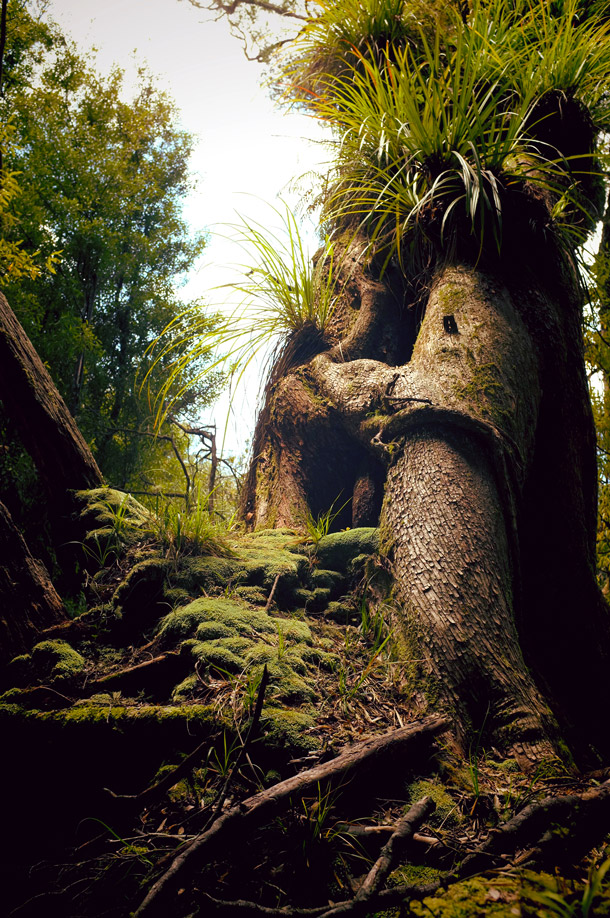
A peek inside Te Urewera National Park. (Photo: John Payne, Flickr CC BY-NC-ND 2.0)
BOYD: Well, that's a great question, and, you know, indigenous cultures around the world, whether in Canada the United States or New Zealand and Australia, indigenous cultures have never seen nature as property. They've always seen nature as relatives, as part of a community to which they belong. So, you know, if you think given the great American conservationist Aldo Leopold said, "The only way we can solve all of these problems is to stop treating nature as a commodity which we own, and recognize nature as a community to which we belong," and I think although Leopold, although he expressed that very eloquently, was just restating something that's been core to the societies and the cultures of indigenous people around the world. And so, what's really fascinating from a contemporary perspective is that the resurgence of some of these indigenous cultures is resulting in laws in western countries, such as the United States and New Zealand, where laws and governments are actually recognizing the rights of nature.
[MUSIC: Paul Halley/Eugene Friesen/John Clark/Jim Scott/Glen Velez/Humpback Whale, “Lullaby From The Great Mother Whale For the Baby Seal Pups” on Concert For the Earth, Living Music]
CURWOOD: That’s environmental lawyer David Boyd. Our discussion about the Rights of Nature continues just ahead here on Living on Earth. Don’t go away.
ANNOUNCER: Funding for Living on Earth comes from you our listeners, and United Technologies - combining passion for science with engineering to create solutions designed for sustainability in aerospace, building industries and food refrigeration. UTC companies such as Otis, Carrier, Pratt & Whitney and UTC Aerospace Systems are helping to move the world forward. You can learn more about United Technologies by tuning in to the Race to 9 Billion podcast, hosted by UTC’s Chief Sustainability Officer. Listen at raceto9billion.com. That’s raceto9billion.com. This is PRI, Public Radio International.
[CUTAWAY MUSIC: Paul Halley/Eugene Friesen/John Clark/Jim Scott/Glen Velez/Humpback Whale, “Lullaby From The Great Mother Whale For the Baby Seal Pups” on Concert For the Earth, Living Music]
CURWOOD: It’s Living on Earth, I’m Steve Curwood.
We’re back now with David Boyd, author of "The Rights of Nature: A Legal Revolution That Could Save the World", to continue our discussion of the notion of recognizing the legal rights of ecosystems and natural features to be themselves. So, David, where did this idea really start to catch on?
BOYD: Well, the idea, actually, you know, beyond indigenous cultures, the first time this idea arose in a legal context was actually in the United States. It happened when Walt Disney, the great movie mogul, was proposing a ski resort development in a beautiful area of California's Sierra Nevada Mountains, known as the Mineral King Valley, and in one of the first environmental lawsuits in American history the Sierra Club challenged the approval of this ski resort and actually succeeded in getting an injunction to block its construction. However, Walt Disney appealed that court decision and was successful in overturning the injunction on the basis that the Sierra Club had no standing to bring the lawsuit, that no Sierra Club members were being personally or financially harmed by the project, and the Sierra Club then appealed that to the Supreme Court of the United States, you know, the highest court in the land.
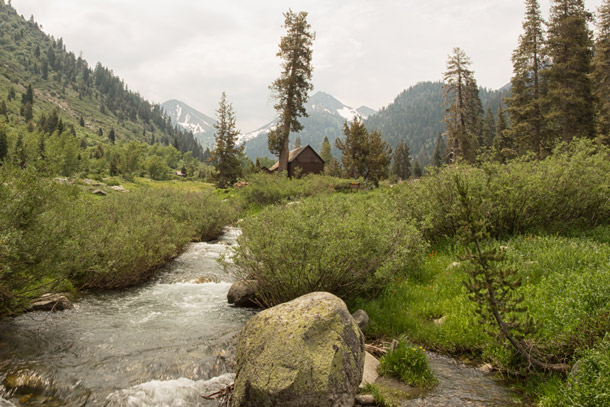
Mineral King is a valley located in Sequoia National Park and the subject of a historic legal debate over the Walt Disney Company’s right to develop a ski resort on the land. (Photo: Shawn Hinsey, Flickr CC BY 2.0)
And so when the, this case about the proposed ski resort in the mineral King Valley went to the Supreme Court of the United States, Justice Douglas wrote a very powerful dissenting opinion in which he argued that if ships and municipalities and corporations could be viewed by the law as persons, then so too should Pileated woodpeckers, coyotes, trees, and the valley itself. And that decision of the US Supreme Court could have marked a turning point in the history of law, but instead became kind of an academic footnote. Justice Douglas was unable to persuade any of his colleagues to go along with his radical conception of rights for nature, and so the whole idea of rights for nature kind of languished in academic obscurity from the 1970s until the 21st century, and then it really has been resurrected both in the United States and around the world with increasing frequency over the last 10 years.
CURWOOD: So, talk to me about the first country to include personhood for nature in its constitution and why they did it.
BOYD: The first country to include nature's rights in its constitution was the Latin American country of Ecuador, and Ecuador is a country with a very substantial indigenous population, and it was really indigenous people who were the drivers behind this. So, Ecuador was drafting a new constitution in the years 2006, 2007, and a coalition of indigenous people came forward with the idea that the constitution should include not only human rights but rights for what they call Pachamama, which is a Quechua word for Mother Earth. And they were so persuasive that they managed to convince the citizens assembly that was drafting the Ecuadorian constitution to include a series of articles in that Constitution which do recognize the rights of Pachamama. And that revolutionary constitutional document has now been incorporated into more than 70 different environmental laws and policies in Ecuador, so it's permeating the entire legal system. It's in their criminal code, it's in their environmental code, and those rights of nature have actually been relied upon in about two dozen lawsuits now.
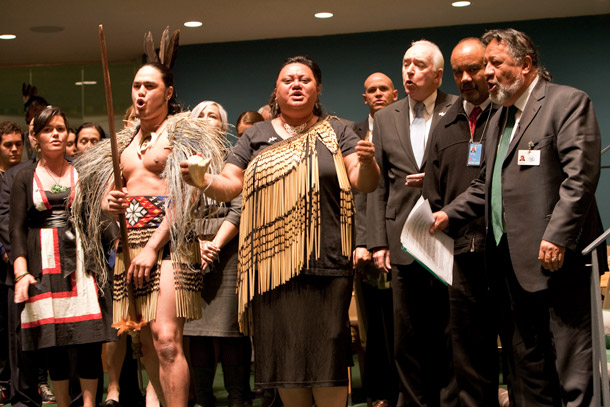
The Māori people played a crucial role in New Zealand’s adoption of personhood rights for Te Urewera National Park – land that has critical historical significance for them. (Photo: Broddi Sigurðarson, Wikimedia Commons CC BY-SA 2.0)
CURWOOD: There's been a lot of focus on New Zealand in this battle for nature's rights. What's happened there? What have they accomplished?
BOYD: Well, New Zealand is actually, I think, the most exciting and the most important story in the whole rights of nature movement. New Zealand is a country, again, that has a substantial indigenous population, and it's the Maori people of New Zealand who have been the drivers behind recognition of the rights of nature in New Zealand. There have been longstanding negotiations in New Zealand taking place to try and right the wrongs that were inflicted upon the Maori by the colonial government over the course of the past 150 years. And about five years ago a fascinating agreement emerged dealing with a river called the Whanganui river which is of great cultural importance to certain Maori sub-tribes, and this agreement was revolutionary in that it designated the Whanganui river as a legal person and articulated a series of rights that the river possesses and then created a guardian kind of model which would be comprised of Maori individuals and the government of New Zealand individuals who have a mandate to ensure that the rights of the Whanganui river are protected.
That agreement was translated into law. A law was passed by the New Zealand Parliament earlier this year, and that was actually the second rights of nature law because in the interim, a second law had been passed dealing with an area formerly known as Te Urewere National Park, and, again, this was land that had been wrongly taken from the Maori over the course of the past 150 years. The National Park was created in the 1950s on land that the Maori at that time and for all time had consistently asserted was their land.
Now, in the course of negotiations between the New Zealand government and the Maori, they actually reached a verbal agreement that the government would return that land, return the National Park to the Maori. But at the eleventh hour the prime minister of New Zealand phoned the chief negotiator for the Maori and said, “We can't do that. It's a bridge too far”. And any other human being who I think had been through that grueling course of negotiations with the whole back story of mistreatment over the course of a century would have maybe walked away. But to Mattie Kruger, this incredible Maori individual, he actually just turned the other cheek to that insult and said, “OK well let's figure out a different solution,” and the solution that the Maori put forward was why don't we take this area and remove its national park status, but designate it as a legal person and then take the government of New Zealand's title to that land and give it to the legal entity we've created. So, in effect the land will own itself.
And so this area of 400,000 acres on the North Island of New Zealand is now the first place I'm aware of in the world where humans have relinquished our assertion of ownership and recognized that it's actually probably more sensible and certainly more sustainable for the land to own itself.
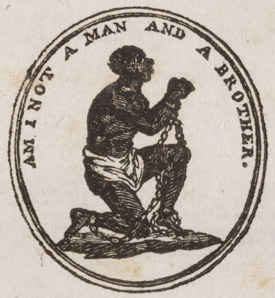
The legal case Somerset v Stewart gave black slave James Somerset personhood rights under British law, and has been cited by environmental lawyers in their personhood claims for nature. (Photo: Wikimedia Commons)
CURWOOD: So, where is the United States on this issue? What have been our legal turning points for nature?
BOYD: Well, you know, the United States is a fascinating country from a legal perspective. As I mentioned earlier, it was the Sierra Club lawsuit about the Mineral King Valley that led to this whole idea of rights of nature gaining currency, but more recently what we've seen in the United States is a revitalization of those ideas at the community level. So, we have a grassroots movement in the United States that is achieving remarkable transformation.
So, the first American community to pass a “rights of nature” ordinance was a small rural community in Pennsylvania called to Tamaqua Borough, and the citizens there were really concerned about a proposal to spread sewage sludge on agricultural land around their community, and they were worried about the potential impacts on their drinking water. And what they found, and this has kind of been consistent over the past decade, they found that the American environmental laws, both federal and state, were really not doing the job of protecting their drinking water from these kinds of threats. And so they took a different route, and they passed this “rights of nature” ordinance, and that precedent that was set by Tamaqua Borough some 12 years ago has now been followed in over three dozen different American communities ranging from Santa Monica, California, to Pittsburgh, Pennsylvania.
So, you know, this has really become one of the most intriguing and I think promising battlegrounds in the United States for the future of environmental prosperity, environmental sustainability, and democracy as these community rights of nature ordinances.
CURWOOD: Now there's a lawsuit filed against the state of Colorado that seeks to win personhood for the Colorado River. What are the problems that the river is facing, and how would legal personhood help the Colorado?
BOYD: Well, the Colorado River which is, as you know, one of the great natural phenomenons of the United States, having carved the Grand Canyon -- I mean just sit back for a moment and consider that, that the Grand Canyon was carved over eons by the Colorado River -- I think the biggest single problem facing the Colorado river in the year 2017 is human overexploitation. I mean, this is a once great river which in some years is reduced to a trickle before it reaches the ocean, and that's because too many people are taking too much water for agriculture, for industry, for municipal uses, and what recognizing the rights of the Colorado River would do, you know, what kind of rights does the Colorado River need? It needs, at its most basic level, it needs the right to a minimum flow of water.
CURWOOD: So, you're an attorney. What are the odds of the Colorado winning?
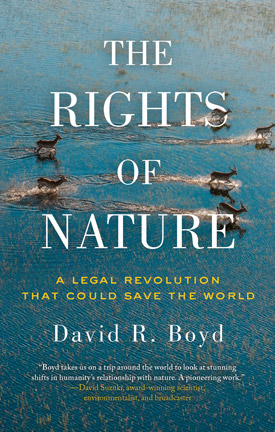
The Rights of Nature: A Legal Revolution That Could Save the World. (Photo: Courtesy of ECW Press)
BOYD: I would say that it's a David and Goliath struggle, to be honest. The American legal system is more conservative than the legal systems in other countries, but all it takes really is one judge with the courage of her or his convictions to do what is right in this case and to make a judgment that does set a precedent in the United States.
And you know one of the interesting cases that rights of nature lawyers like to talk about is a case that was brought centuries ago by an escaped slave named James Somerset in the United Kingdom, and James Somerset actually managed to get a lawyer to represent him in court and he brought a lawsuit arguing that he was a human being and entitled to the same human rights as other people, and of course, you know, there was huge backlash, people saying, you know, “Our economy is built on the foundations of slavery and we'll all suffer terribly if this individual has rights recognized,” but the judge in that case, Lord Mansfield, issued a judgment in which the key phrase was, “Let justice be done though the heavens may fall”, and he did grant human rights to James Somerset in a case that was integral to the abolitionist movement, and what we're looking for now in the United States is a judge with courage similar to that, to make a precedent-setting decision on behalf of nature.
CURWOOD: David, let's say that nature, elements of nature, become legal persons. In our court system you need humans to act as guardians and even land managers especially if the land is being subject to activities from tourism to some extraction. So, how can we always trust humans to be good stewards for the Earth?
BOYD: Well, that's the question that they've answered in New Zealand, Steve. So these laws that...the two laws they've passed in New Zealand designating the Whanganui river and Te Urewera as a legal person and then transferring title to those legal entities, those laws also make it very clear that the guardians established by the laws have a legal mandate to ensure that the rights of those ecosystems are protected. And what the laws actually say in New Zealand is that the guardians have an obligation to protect and preserve the biological diversity, the ecological integrity, and the cultural heritage of those ecosystems in perpetuity. So, that's a crystal clear legal mandate, and I am confident that there are literally millions of people in the United States and Canada who would be thrilled to have the opportunity to serve as legal guardians on behalf of ecosystems, species and animals in their communities.
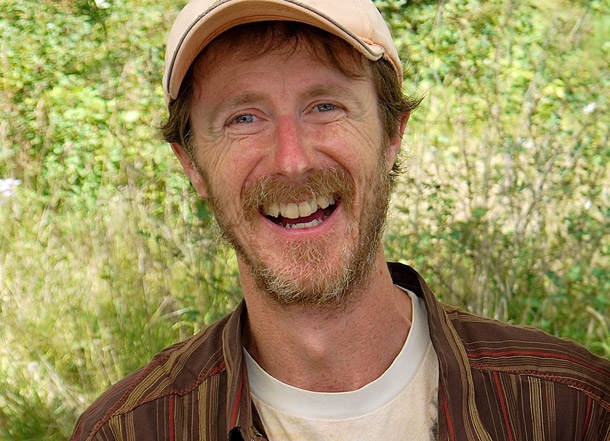
David Boyd teaches at the University of British Columbia. (Photo: Courtesy of ECW Press)
CURWOOD: So, David, when you run into skeptics, what's the one thing you say that you think has gotten you the most conversions to this way of thinking?
BOYD: I guess if there's one argument that actually has tended to maybe change the minds of some critics, it's the comparison with corporations. Corporations have all kinds of rights, for better or for worse, under Canadian and American law, and when you put it to people that, “Why should corporations have rights and not rivers?” You know, neither of them are humans per se, but that idea that rights can extend beyond humans to other entities or when it's put in that kind of a context, I find people tend to stake a step back and go, “Oh, let me think about that”.
CURWOOD: In other words you're saying that you're not only to elevate the rights of nature, but you're also going to change the way humans relate to nature.
BOYD: Well, I think that's absolutely essential. I mean, as a lawyer I tend to focus on the law, but what we really do need to do is transform our culture. We have to stop thinking of ourselves as separate from and superior to the rest of the natural world. We have to begin to believe in ourselves as part of a community that we belong to, and you know, there's really fascinating scientific evidence about this over the past two decades. We've made incredible leaps in terms of our understanding of DNA, the basic building block of life. And we now know that human beings, we share DNA not only with chimpanzees and gorillas; we share DNA with every other form of life on the planet, from fungi to fir trees, from aardvarks to zebras. And so, if you look at life on Earth through that lens, we
BOYD: It's been a real delight. Thanks for having me on the show, Steve.
Related links:
- The Rights of Nature: A Legal Revolution That Could Save the World
- Te Urewera National Park
- Ecuador’s Constitution codified the “rights of nature” into law
- More on the legal fight to save the Colorado River
- David Boyd’s website
BirdNote: Birds of Paradise
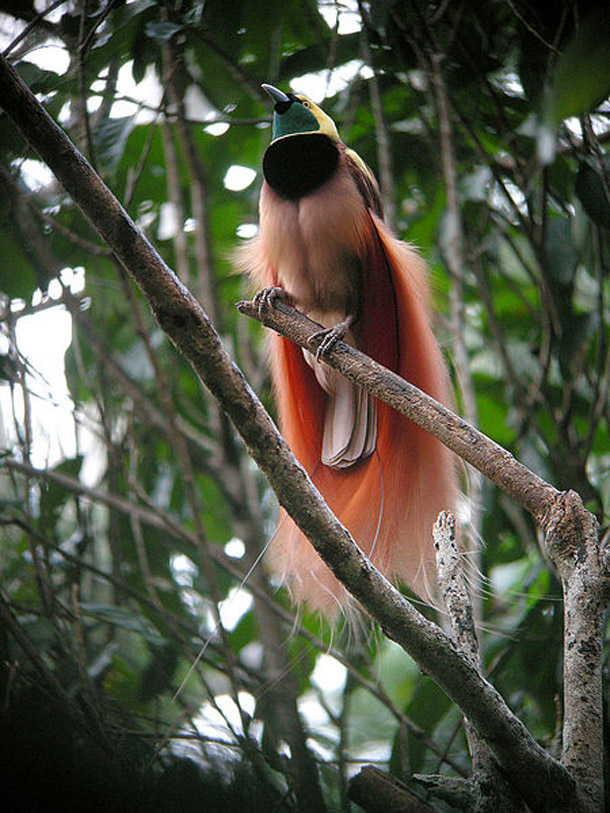
Birds of Paradise are distinct for their bright colorations and extravagant feathering. Their flashy appearances are a result of sexual selection. (Photo: Mark A Harper)
[MUSIC: BIRDNOTE® THEME]
CURWOOD: If you like the beautiful and photogenic, today’s BirdNote® is for you. Mary McCann takes us to the tropical Pacific to meet one of its most exotic, and colorful natives.
[AMBIENT NEW GUINEA FOREST AND RAGGIANA BIRD OF PARADISE CROWING AT LEK]
It is early morning on the island of New Guinea, as the lowland forests erupt with the crowing calls of male Raggiana Birds of Paradise.
[RAGGIANA BIRD OF PARADISE]
Groups of male Raggiana Birds of Paradise perform elaborate displays to attract females. The size of small crows, the males have a yellow head, bright green throat, and a lush mass of fine, russet-orange plumes that hang well beyond their tails. In a sequence known as “the flower display,” the males hang upside down with their wings flexed downward, while flaunting the lustrous russet plumes upward.
[RAGGIANA BIRD OF PARADISE]
“Birds of Paradise”— an aptly exotic name for this most varied and extravagantly decorated group of birds. All forty-three species are found on New Guinea, or nearby.
Picture one named the Ribbon-tailed Astrapia as it flies along the forest edge.

All 43 species of Birds of Paradise are found on the island of New Guinea. Their elaborate feather formations can sometimes make flight difficult. (Photo: Jerry Oldenettel)
[RIBBON-TAILED ASTRAPIA]
With an emerald-green head and velvety black body, the Astrapia trails two slender, white tail-plumes a full three feet behind its body. They undulate like fine ribbons in the breeze.
I’m Mary McCann.
###
Written by Bob Sundstrom
Calls of the birds provided by The Macaulay Library of Natural Sounds at the Cornell Lab of Ornithology, Ithaca, New York. Raggiana Bird of Paradise and Ribbon-tailed Astrapia recorded by Eleanor Brown.
Producer: John Kessler
Executive Producer: Chris Peterson
© Tune In to Nature.org November 2017 Narrator: Mary McCann
https://www.birdnote.org/show/birds-paradise
CURWOOD: And for pictures, bask in our website, LOE.org.
Related links:
- The “Birds of Paradise” story on the BirdNote® website
- About the Ribbon-tailed Astrapia from the Cornell Lab of Ornthology
- Birds of Paradise Project, Cornell Lab of Ornithology
CURWOOD: Next time on Living on Earth, why fisheries matter to landlubbers.
SEAVER: Too often we stand on that dock and we gaze wistfully out at the wine-dark sea, and we think that a fishery is something that happens over the horizon of our attentions. But it is people, it is action, it is an economy.
CURWOOD: And it requires working waterfronts as well as fish. That’s next time, on Living on Earth.
[MUSIC: Ruben Gonzalez, “Date una vueltecita” on Momentos, Escondida/Cuban Essentials]
CURWOOD: Living on Earth is produced by the World Media Foundation. Our crew includes Naomi Arenberg, Bobby Bascomb, Savannah Christiansen, Jenni Doering, Noble Ingram, Jaime Kaiser, Don Lyman, Helen Palmer, Adelaide Chen, and Jolanda Omari. Tom Tiger engineered our show, with help from Jake Rego. Alison Lirish Dean composed our themes. You can hear us anytime at LOE.org - and like us, please, on our Facebook page - PRI’s Living on Earth. And we tweet from @LivingonEarth. I'm Steve Curwood. Thanks for listening.
ANNOUNCER1: Funding for Living on Earth comes you, our listeners, and from the University of Massachusetts, Boston, in association with its School for the Environment, developing the next generation of environmental leaders. And from the Grantham Foundation for the protection of the environment, supporting strategic communications and collaboration in solving the world’s most pressing environmental problems. Support also comes from the Energy Foundation, serving the public interest by helping to build a strong, clean, energy economy, from Gilman Ordway, and from SolarCity, America’s solar power provider. SolarCity is dedicated to revolutionizing the way energy is delivered by giving customers a renewable alternative to fossil fuels. Information at 888-997-1703. That’s 888-997-1703.
ANNOUNCER2: PRI. Public Radio International.
Living on Earth wants to hear from you!
Living on Earth
62 Calef Highway, Suite 212
Lee, NH 03861
Telephone: 617-287-4121
E-mail: comments@loe.org
Newsletter [Click here]
Donate to Living on Earth!
Living on Earth is an independent media program and relies entirely on contributions from listeners and institutions supporting public service. Please donate now to preserve an independent environmental voice.
NewsletterLiving on Earth offers a weekly delivery of the show's rundown to your mailbox. Sign up for our newsletter today!
 Sailors For The Sea: Be the change you want to sea.
Sailors For The Sea: Be the change you want to sea.
 The Grantham Foundation for the Protection of the Environment: Committed to protecting and improving the health of the global environment.
The Grantham Foundation for the Protection of the Environment: Committed to protecting and improving the health of the global environment.
 Contribute to Living on Earth and receive, as our gift to you, an archival print of one of Mark Seth Lender's extraordinary wildlife photographs. Follow the link to see Mark's current collection of photographs.
Contribute to Living on Earth and receive, as our gift to you, an archival print of one of Mark Seth Lender's extraordinary wildlife photographs. Follow the link to see Mark's current collection of photographs.
 Buy a signed copy of Mark Seth Lender's book Smeagull the Seagull & support Living on Earth
Buy a signed copy of Mark Seth Lender's book Smeagull the Seagull & support Living on Earth

